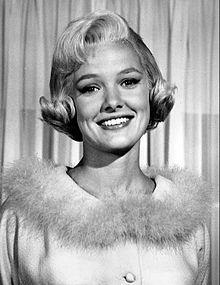Marabou (fashion)

Marabou (historically spelled marabout) describes a certain type of
turkey feathers have been used as a substitute.[2] The advantage of marabou is that it takes dye well, making it a very versatile trimming for dress, and makes an effective substitute for fur.[1] While marabou has been widely used as a fashion trimming since the late 19th century,[1] it is also often used in fly tying for making up the lures ('flies') used for fly fishing.[2][3]
In fashion

"Marabout" was a very popular trimming from the late eighteenth century onwards.
Since the 20th century, marabou (spelt without a T) has become associated with lingerie and sex appeal. The
Metropolitan Museum states that 'no object better epitomizes the sex kitten glamour of the 1950s than the marabou mule.'[6] Marabou mules are popularly associated with glamorous 1950s actresses such as Marilyn Monroe, who wore them in The Seven Year Itch.[7][8]
References
- ^ a b c / "Mantle. c. 1885, by Redmayne & Co". V&A Search the Collections. Victoria and Albert Museum. Retrieved 8 October 2014.
- ^ ISBN 9781586856922.
- ISBN 9781626367531.
- ISBN 9780810840041.
- ^ a b Reports by the Juries: On the Subjects in the Thirty Classes Into which the Exhibition was Divided. W. Clowes. 1852. p. 387.
- ^ "Pair of mules, American, 1950s". The Collection Online. Metropolitan Museum of Art. Retrieved 8 October 2014.
- ISBN 9781416546221.
- ISBN 9781845969875.
